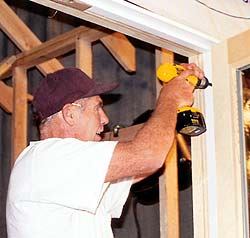Clutch Settings and Chucks Among the models we tested, the clutches performed very differently. More important than the actual number of clutch settings (most models have around 20) is the range of torque from lowest to highest settings. At the lowest setting, a drill driver should start to slip in time to prevent stripping out something like a strike-plate screw. The Bosch, Hitachi, and Milwaukee performed well at lower settings. At the highest setting, a drill should not prematurely slip during a high-torque application such as driving a 2-1/2-inch hinge screw. In our tests, however, several models lacked power in the highest clutch setting (Bosch, Metabo, Porter- Cable). For high-torque applications with these models, you have to use the full-power drill setting, relying on “feel” to determine tightness when driving longer screws or lag bolts. The best high clutch performers were DeWalt, Milwaukee, and Ryobi. Overall, the Hitachi, Milwaukee, and Panasonic drills had both good low and high settings, indicating an extensive clutch range. The Milwaukee was the best performer, displaying sensitivity in low clutch settings and high torque in high settings.
14.4-Volt Cordless Drills
11 MIN READ
